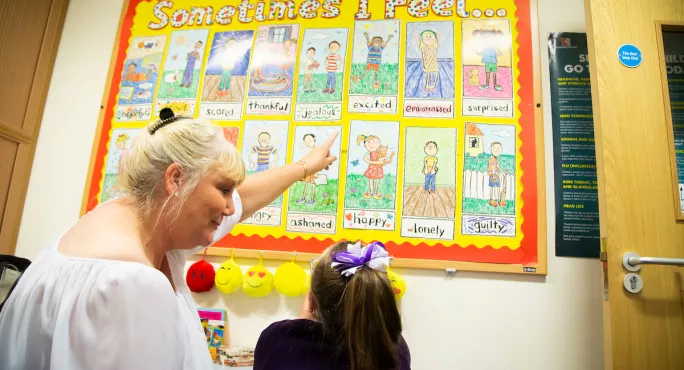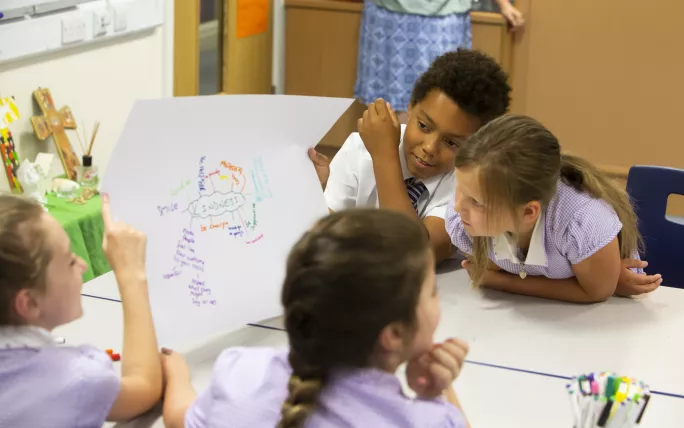Working together to support wellbeing in schools

Would you feel confident speaking to a seven-year-old who has recently lost a close relative? Do you know what to tell your panic-stricken Year 6 class in the week before they take their Sats? And would you really feel comfortable starting a conversation about mental health with your Year 3s?
Most primary schools are aware of how important it is to cultivate an environment that benefits and nurtures the mental health of pupils, staff and carers, but finding the right way to do it can be difficult. How can you be sure what constitutes good advice? How do you know where to even start?
“We hear a lot about having a whole-school approach to mental health and wellbeing, and embedding it in your school’s culture,” says Hannah Kinsey, head of training and consultancy at mental health charity YoungMinds. “But it can be really difficult to know what the first step towards that is, and what the approach will look like for a headteacher, a teacher or a teaching assistant.”
This was one of the issues that prompted the founding of the Mentally Healthy Schools website ─ an initiative launched by The Royal Foundation’s Heads Together programme, which campaigns to tackle stigma around mental health.
The website was piloted at the start of this year after a high-profile launch by Kate Middleton, the Duchess of Cambridge. It’s now freely available to all schools, and offers information, advice and guidance on all aspects of mental health to staff at all levels. This advice ranges from tips on how to start a conversation with a child or a parent through to in-depth understanding of teaching social and emotional skills. And all the resources have been curated and quality assured by experts at the charities involved.
“There’s still a lot of concern in schools about doing things wrong, or saying the wrong thing,” explains Kinsey, who has been working with around 50 pilot schools to help them benefit from the Mentally Healthy Schools site. “A lot of it is around confidence, and what some schools really struggle with is knowing what information is good information, and what is less reliable.”
Mentally Healthy Schools
This is a situation that Michelle Forrest, headteacher of St John Fisher Roman Catholic Primary School in Knowsley ─ one of the site’s pilot schools ─ recognises. Her school has created its own PSHE curriculum with a strong focus on mental health, and the Mentally Healthy Schools site has played a big role in its development.
“If you search online for information ─ for example, if a child has got anger issues or low self-esteem ─ then there are thousands of sites and blogs that you can go on, but you can’t really validate them. You’re kind of guessing about how reliable they are.”
This is not an issue with the Mentally Healthy Schools resources, since the site has been developed by renowned mental health organisations the Anna Freud National Centre for Children and Families, Place2Be, and YoungMinds ─ with guidance from the Centre for Mental Health, and support from the NAHT heads’ union.
“There are lots of tools on there that mean you can audit your mental health and wellbeing provision within your school, which is really helpful to me as a head working with governors,” says Forrest.
“Also, we often have parents coming in asking or worried about mental health issues, and we now have somewhere to direct them where they can find reputable information that isn’t just based on an opinion like a lot of online advice is. It is all backed up, and it even comes with recommended further reading, which is great.”
Handling bereavement and anxiety
Through her work with the pilot programme, Kinsey has heard how schools in a variety of settings have been using the Mentally Healthy Schools site, not only to deal with severe mental health issues, but also with situations that the majority of children will encounter at some point, such as bereavement and anxiety.
“In one pilot, at a very multicultural school in London, children were speaking specifically about things like Brexit, the Manchester bombing or the London Bridge attack,” she explains. “Kids pick up on what is happening, and they were feeling really worried and anxious about the state of the world in general.
“So how do you acknowledge these things with pupils in a primary school? It’s a real challenge, but it will come up, so it is important to be prepared.”

There’s a range of resources on the site to help schools discuss issues like anxiety, including strategies for supporting an anxious child, and activities designed to help children discuss their feelings.
“We’ve got children who are anxious for a variety of different reasons, and we’ve been able to go in and find resources that our learning mentor and teacher can work specifically with that child on, but also things that we can direct parents to at home,” says Forrest. She adds that the site has also proved useful when supporting children who have experienced a recent bereavement.
“It’s important that schools have reliable advice when there’s been a bereavement, because the way that a child deals with it now will determine how they cope with death in the future,” she says. “It was helpful to have reliable information.”
Among the bereavement resources online are videos explaining how children experience grief, guidance on what schools can do to ensure they have structures in place to support grieving children, and practical activities that can help young children to cope, such as the creation of a “memory box”.
“There’s a whole quality assurance process that sits behind the resources on the site ─there has to be a proven evidence base behind it,” says Kinsey. “But there’s also a teacher advisory group to make sure that things aren’t too clinical ─ it has to be presented in a way that schools can understand.
“Kids are absorbing information from everywhere ─ their parents and the media ─ so these kinds of conversations will come up whether you want them to or not. The website is about giving schools somewhere to go that can help when they need it.”
Forrest agrees but emphases that the tools can also be used before problems have been reported.
“It’s not just about reacting when you have a problem with a particular child, she says. “The site is also great for pre-empting problems. We don’t want to wait for issues to arise, we want to talk about mental health with all parts of the school community early on, and the site has been very useful for that.”
For more information and to access the wealth of resources and advice, visit the Mentally Healthy Schools website.
